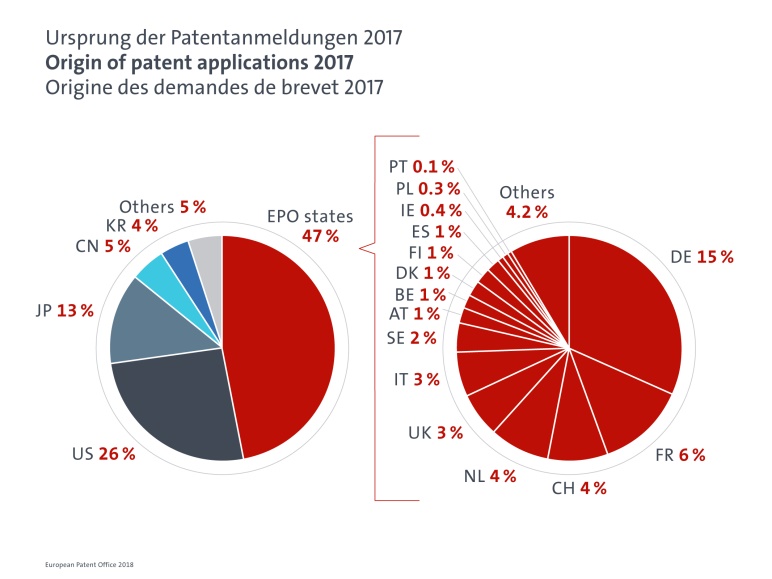
The 2017 EPO's Annual Report- what you need to know
The EPO 2017 Annual Report stated that European patent applications hit an all-time high in 2017. The EPO received nearly 166,000 patent applications in 2017, an increase of +3.9% from the previous year, with granted patents also increasing by +10.1% to nearly 106,000.
The recently published EPO 2017 Annual Report discloses significant figures relating to the patent landscape worldwide as well as in Europe.
One of the issues in the patent application process has been the delays due to the number of applications and the backlog at the EPO. According to the report, the EPO has been endeavouring to reduce the backlog of work by processing more work than it has received. This has allowed faster response rates and therefore greater certainty for applicants.
Applications from the EPO’s 38 member states grew by +2.8% from 2016 and accounted for 47% of the total. The five most active countries being the US, Germany, Japan, France and China, with China showing yet another double digit increase of +16.6%.

Analysis of the origin of patent applications in the largest fields of technologies have shown that countries such as China and South Korea are progressing into specific areas such as the ICT field, whereas others, such as the US and EPO states, have shown a greater variation of the field of applications. This provides further evidence for the recent study by the EPO on “Patents and the Fourth Industrial Revolution”. You can find our review on this study here.
The EPO has been actively involved in IP5 initiative which helps global harmonisation and streamlining of procedures, eliminating unnecessary duplication of work among offices.
Overall, Europe continues to export more inventions to the ‘IP5’ regions than it imports, indicating the strong position of Europe in terms of innovation.
The top technology fields where most applications were made are Medical Technologies, Digital communication and Computer technologies. The strongest growth was recorded by the biotechnology (+14.5%) and pharmaceuticals (+6.2) fields. Following the report on the Life Sciences Industrial Strategy prepared by the life sciences sector for the UK government, the increased trend in medical technologies in the UK was well-within expectations.

The importance of patents for SMEs is another significant result of this report as one in four applications received by the EPO came from an individual or SME. To further support the SMEs in their patent journey, EPO has also published a set of case studies on European SMEs. These case studies demonstrate how the value of IP can be used in the most effective and efficient way within organisations.
While SMEs have significant presence in patent applications at EPO (24%), large enterprises such as Huawei, Siemens, LG, Samsung and Qualcomm are responsible from the 69% of the patent applications at EPO. The Chinese electronics company Huawei takes top place in the list of most active patent applicants which is the first time in EPO history that a Chinese company achieved this.
The full report can be accessed here.
We as Wynne-Jones IP are closely following the developments realized by EPO directly as well as through our involvement with the pan-European law firm AIPEX.




![The Supreme Court’s decision [Sky]kicks into touch The Supreme Court’s decision [Sky]kicks into touch](/media/1873/gavel-3-1236445-1279x850.jpg?anchor=center&mode=crop&width=385&height=215&rnd=132255583300000000)




